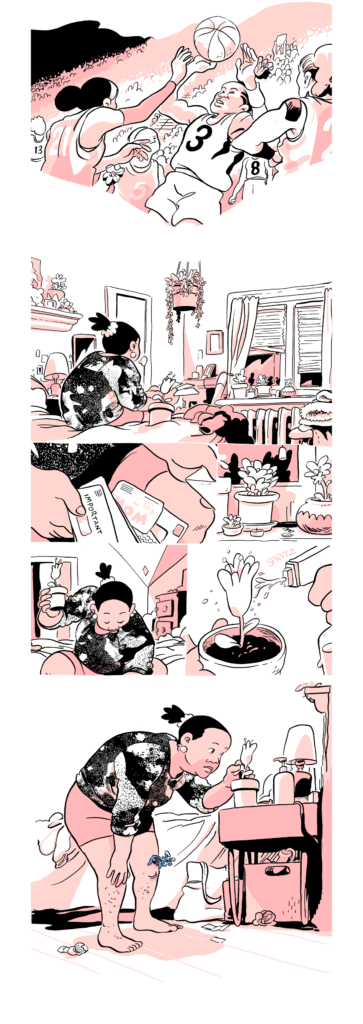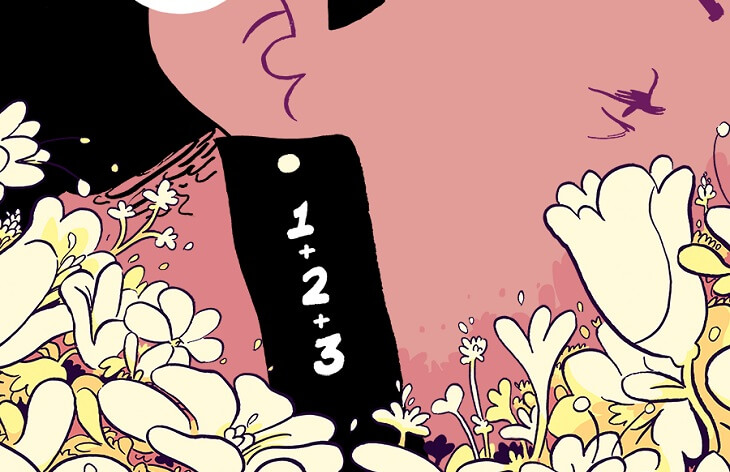I went into Four Years quite unaware of what to expect beyond just a brief synopsis from the Ignatz Award page and a tweet from creator K Czap. But what I got was a really lovely, well-paced exploration of self growth and friendship through scenes all expertly weaved together with color and movement.
Four Years
K Czap
Czap Books/online
2018-2022
CW for the comic: discussion and depiction of assault and abuse.
This review contains some spoilers for the webcomic and both Vol. 1 and Vol. 2.
Four Years Collected: Vol 2 by K Czap was recently nominated for the 2022 Ignatz Awards and with that nomination, Czap shared the entirety of their comic online for readers to easily access in a linear manner. Originally published as a webcomic before being self-published in 2 physical volumes, Four Years tells the story of Betty Yaris, a 32-year-old woman who is spending time with her friends and living her life when she suddenly catches a glimpse of someone who she is certain is herself, from four years in the future.
Four Years thread 1/24 pic.twitter.com/J9dlDyK3Hj
— k czap – MICE! 25B🌷 (@charmgardens) August 17, 2022
I think it’s been a decent chunk of time since I read a comic this easy to get lost in — I couldn’t put it down. Reading it in continuous webcomic format certainly played into the overall flow of Four Years, but I can imagine that there’s a sense of that flow captured in the physical volumes of well. Opening up on Betty getting her ears pierced, the story follows along with her daily life as she meets up with a group of friends – scenes easily flowing right into another as you read.
I mention this easy flow of scenes so early because it really sets up a rhythm to the story and conversations that are happening throughout. Even as Betty explains to her friends about this woman who she believes to be herself in the future, the simple flow of scene and conversation keep the story moving at a gentle pace – almost reflective of the friendships, sense of community, and self-growth that Betty is a part of throughout.
Czap’s art style has a very soft and fluid feeling to it, from the character design to the color palette that has been used (soft pinks, whites, and blacks). The fluidity of Four Years‘ art really works in favor of the gentle flow of the story, helping to create scenes that overlap with each other in a very natural way.
Four Years has a slice-of life-feel to it, especially in how Betty and friends talk throughout. There are snippets of the characters’ dialogue as the comic goes on, mostly centered around things like the group planning a trip to LA, Betty telling her friends about seeing a future version of herself, and a conversation between Betty and Vivvie. There are little breakaway moments where the characters directly address the reader in between those conversations, providing little thoughts and extra insight here and there.
The overall story is a collection of moments between friends and the small community they’ve come to create together. Betty and friends are planning a trip to LA to spend some time on the beaches, but she is also dealing with an underlying health condition (though it’s not your typical health concern). That trip pervades conversation and dwells in Betty’s mind as she ponders over seeing her future self and generally ruminates over where she will be in just four short years.
 That rumination on growth is very much the overarching theme of Four Years and it’s one I really enjoyed, especially in Czap’s use of plants and flowers that start to blossom and grow around Betty and friends a little ways into the comic. Plants are a pretty common thematic representation of growth in storytelling and Czap’s use of them is really poetic in a way, as they help weave conversations together as Betty thinks on how she met her friends and what exactly seeing her future self means.
That rumination on growth is very much the overarching theme of Four Years and it’s one I really enjoyed, especially in Czap’s use of plants and flowers that start to blossom and grow around Betty and friends a little ways into the comic. Plants are a pretty common thematic representation of growth in storytelling and Czap’s use of them is really poetic in a way, as they help weave conversations together as Betty thinks on how she met her friends and what exactly seeing her future self means.
That flower growth changes depending on where Betty is. For example, there is a small flower sprouting from Betty’s knee that she eventually goes to the doctor over. But when she is with her friends, her chosen family, the flower growth is large! It practically takes over the entire scene and covers the characters. This really reads to me as Betty feeling comfortable and safe with her friends and as a visual indicator that Betty has a loving, supportive community in her friends – something past Betty didn’t seem to have.
It’s never really stated what the growth on Betty’s knee means, but I like to think it ties into Betty seeing her future self and just having a personal realization that she’s going to be ok in the future. She has a lovely group of friends who care for each other and seem like they’ll be the type of friends that stick together through thick and thin.
Czap’s exploration of self-growth and friendship through the lens of Betty is delivered in a poetic manner that honestly warranted two reads on my end. Readers are in for a read which feels almost brief in a way, very much like a poem, but one that keeps you engaged throughout with wanting to see more of Betty’s life and just what she has in store.


